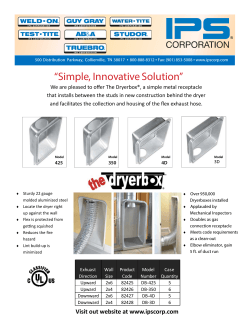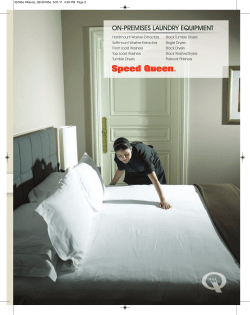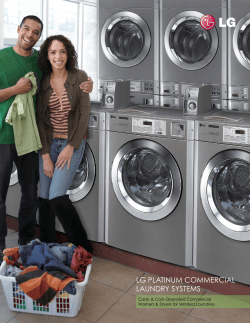
CLOTHES WASHER & DRYER BUYING GUIDE
COURTESY OF BOSCH CANADA CLOTHES WASHER & DRYER BUYING GUIDE Toronto Hydro encourages customers to choose the right appliance that will meet their lifestyle, budget and needs. An important consideration is choosing energy-efficient (ENERGY STAR ) appliances. Customers will not only save money on their electricity bill, but relieve pressure on the electricity grid. Conserving electricity is good for everyone. ® This buying guide will provide you with some ideas on the different options available and help you decide which machine is best for you. Before you buy any washer or dryer, remember: Check the warranty and guarantee — find out from your retailer what’s covered by them and/or the manufacturer. · Make sure to buy from a reputable dealer or retailer. · Keep your receipt — you will need it for warranty purposes. · Make sure that you have the appropriate electrical outlet — a grounded three prong plug. Full-size dryers should be vented outside. · Look for the features you want but don’t be swayed by ones you won’t use. · Different manufacturers use varying names for the same features; however they are beginning to standardize the feature names. · Coordinate the size (capacity) of the washer and dryer, otherwise you’ll lose efficiency. Generally, the dryer is double the capacity of the washer. (i.e. if the washer is larger than the dryer, you’ll end up drying two loads for every one wash) · Choose an ENERGY STAR machine. ENERGY STAR in Canada is a voluntary arrangement between Natural Resources Canada’s Office of Energy Efficiency and organizations that manufacture, sell, or promote products that meet the ENERGY STAR levels of energy performance. · A water efficient front load washer can reduce drying time, saving both water and energy. CLOTHES WASHER & DRYER BUYING GUIDE WASHING MACHINES Front Load Versus Top Load Washing Machines There are two main types of washer models available — top loading or front loading. Both are now available in a number of styles and colours. Front loading machines can be set up side-by-side or stacked in order to save space or fit within your personal style. Top loading washers generally cannot be stacked unless you find a compact or apartment- sized version that is usually portable. Front load washing machines: ·Spin faster than top load washers. Because front loaders spin faster, more water is extracted and therefore you shorten the amount of time needed in the dryer. · May be more expensive than top loading machines. · Use less water — in fact ENERGY STAR washing machines use 25 to 50 per cent less water. · Rely on tumble action to clean clothes and is gentler. Top load washing machines: · Generally cost less than front loading machines, but are less efficient. ·Provide more agitation and may be less gentle on clothes. ·Clothes can be added after the cycle has started. WASHING MACHINE SIZES ·If you’re comparing the capacity size, make sure to use the cubic foot measurement instead of ‘large’ or ‘extra large’. (These are becoming more standardized now.) ·Standard size for height varies by manufacturer, but the standard width is 27”. STANDARD FEATURES Most models include: ·Water temperature setting. Some washers provide combinations, such as “wash with hot and rinse with cold…” (A cold water rinse is recommended — not only will you save on electricity, but clothes will rinse better and be less wrinkled.) ·Extra rinse cycle — this is valuable if you need to ensure a second rinse particularly if you or your family is sensitive to laundry soap residue. Don’t use this cycle unless you need it — it’ll just waste water. ·Wash cycle settings such as: permanent press, delicate and extra soak. OPTIONAL or ADDITIONAL FEATURES · Wash load settings — this allows you to choose the size of the load. · Type of clothing wash options: this allows you to choose a load based on type of clothing (i.e. delicate) or colour (i.e. whites vs. colours) and the machine will adjust the temperature, agitation and duration. ·Steam cycles for both the washer and dryer — some also offer sanitization settings. ·Spin speed — the faster the spin, the drier the clothes. ·Timed dispensers for detergent, bleach and fabric softeners. ·Noise reduction/anti-vibration systems — consider this if your washer and dryer are located close to common or living areas. ·Safety — all machines offer a locking mechanism that prevents the door from opening while spinning. ·Special cycles for jeans, or bulky items like comforters. ·Baby care or allergy cycles that will sanitize clothes. (i.e. Internal water heater to sanitize without bleach) ENERGY EFFICIENCY ·ENERGY STAR qualified washing machines use at least 30 per cent less electricity. They also use up to 50 per cent less water and the combined water and electricity savings can total almost $68 a year. · Wash full loads, versus smaller ones. · Choose cold water wash when possible. STYLE · Optional platforms are available to give your machines height while adding seamless, closed storage for detergents and other accessories. · Washers and dryers are generally 27” wide, but come in varying heights depending on the height of the storage platforms. · Most come in different colours — from white to cherry red. · Some of the newer models have digital screens and LED light indicators. CLOTHES WASHER & DRYER BUYING GUIDE Dryers Both gas and electric models are readily available and depending on your home and needs, one may work better for you. Dryers are not ENERGY STAR rated because the energy consumption does not vary significantly between models. ENERGY STAR clothes washers remove more water allowing dryers to do their job faster. However, the EnerGuide rating should be considered to ensure the highest efficiency. Gas appliances do not currently have EnerGuide labels. If you are purchasing a gas dryer, make sure it has been certified by the Canadian Gas Association (CGA) or Underwriters Laboratories Inc. OPTIONAL or ADDITIONAL FEATURES ·If you’re comparing the capacity size, make sure to use the cubic foot measurement instead of ‘large’ or ‘extra large’ (the sizes are becoming more standard.) ·Standard size for height varies by manufacturer, but the standard width is 27”. ·Some of the newer models have digital screens and LED light indicators that will replace regular knobs or buttons. ·Reverse motion tumbling — to prevent pilling. ·Timers — instead of using one of the preset cycles, you can choose how long you want to run the load. ·Moisture level sensor — the cycle will only stop once the machine stops detecting moisture. ·Drying rack — a rack inside allows you to stack items such as shoes or delicate items in for drying without tumbling. ·Drum light — to help see in the back of the dryer. ·Lint filter — lets you know when to change or clean the filter. If you don’t get this feature, make sure to properly clean the filters regularly. ·Noise reduction/anti-vibration systems — consider this if your washer and dryer are located close to a common or living area. ·Steam cycles to remove wrinkles or freshen clothes; some also offer sanitization settings. STANDARD FEATURES ENERGY EFFICIENCY MACHINE SIZES Most models include: ·Temperature settings — this can be “low, medium, high” or based on type of clothing (delicates, normal) · Cool down cycle to prevent wrinkling. · End of cycle indicator — button or buzzer. ·Today’s new clothes dryers use approximately four per cent less energy than the average of those models in homes today. The main improvements in the energy efficiency of clothes dryers are due to automatic controls that end the cycle by using moisture sensors, therefore eliminating over- drying. · Drying two or more loads in a row makes the most of the heat already generated by your dryer. ·Using a clothes drying rack even just a quarter of the time (instead of a dryer), could save another $21 a year. ·Use moisture-sensing settings to avoid over drying, which wastes energy and can cause clothing to shrink. *Sources: Natural Resources Canada, ENERGY STAR®, Ontario Power Authority, City of Toronto, EPCOR For more details visit: torontohydro.com/wash
© Copyright 2025





















